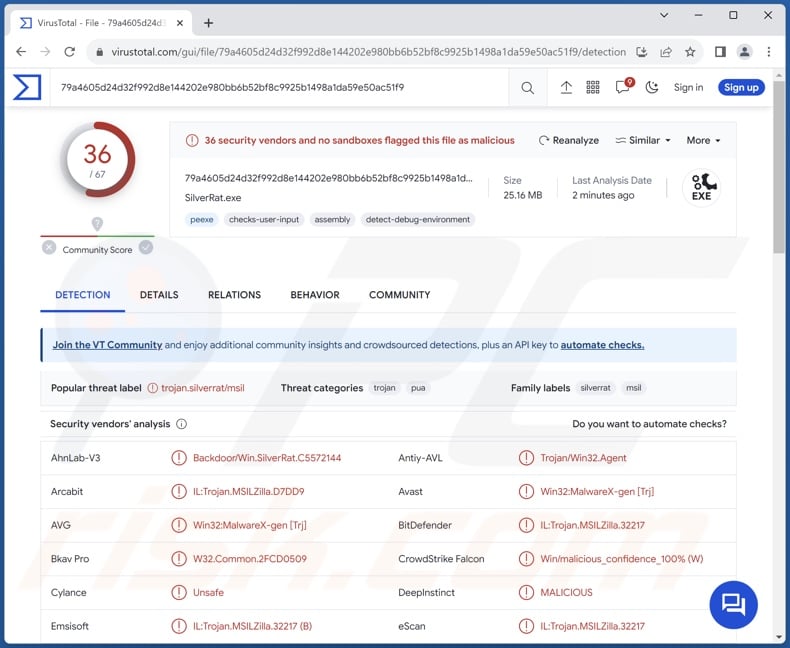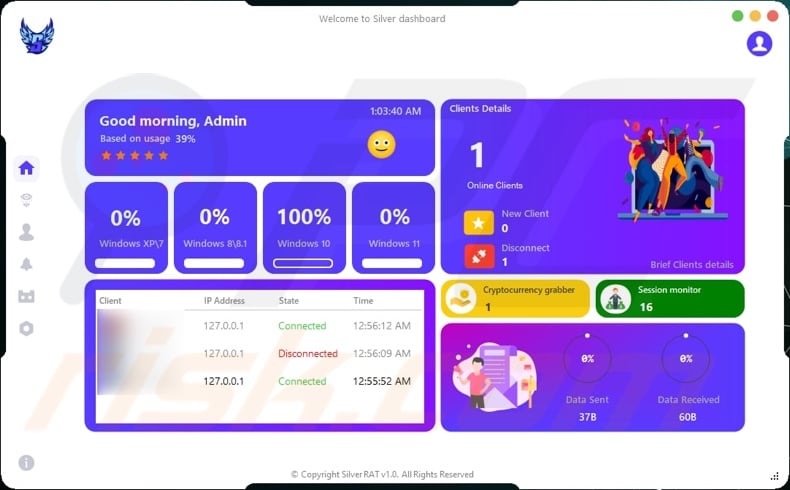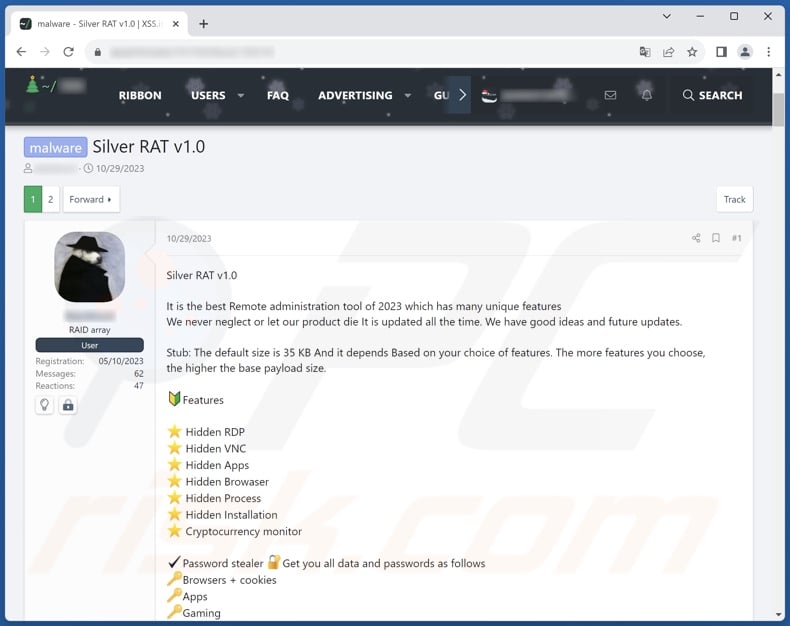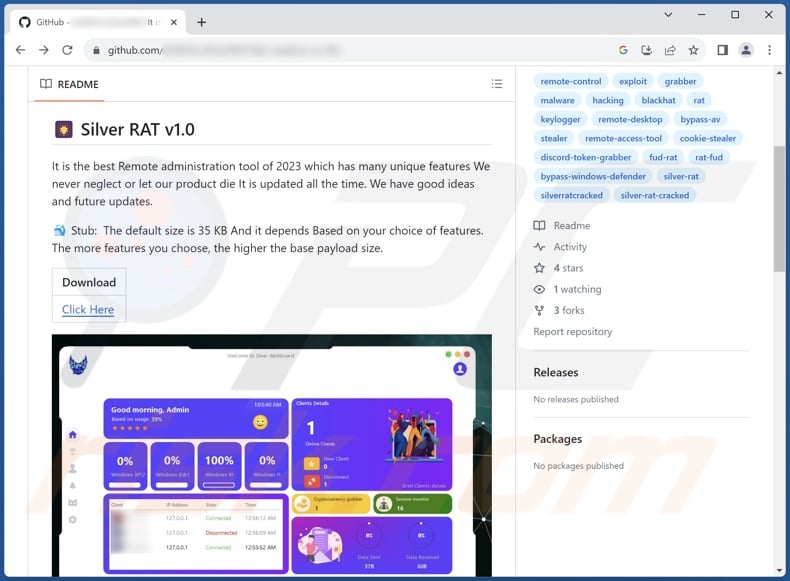How to remove Silver remote access trojan from the operating system
![]() Written by Tomas Meskauskas on
Written by Tomas Meskauskas on
What kind of malware is Silver?
Silver is a Remote Access Trojan (RAT) written in the C# programming language. This malware enables remote access and control over infected machines. It was first noted in the wild in the autumn of 2023.
The trojan is quite sophisticated and versatile. Silver has a wide variety of functionalities, ranging from causing chain infections to stealing information.
At the time of writing, Silver is actively promoted and sold on various hacker forums and other platforms. Some evidence suggests that the developers of this RAT are based in Syria.

Silver malware overview
Remote access trojans operate by enabling remote access and control over compromised devices. Silver has anti-detection and anti-analysis capabilities, including detection evasion by the Microsoft Defender Antivirus and anti-debugging features. Additionally, this program can assign custom names to its malicious processes.
As mentioned in the introduction, the Silver RAT is a highly multifunctional tool – the following is a brief overview of its abilities. This malware can bypass UAC (User Account Control). It can manage files, applications, and processes. It can also browse and search for content on victims' systems, as well as modify, delete, and extract it.
Silver is able to stealthily use browsers and various applications (multiple at a time), even concurrently with the victim. The program can be used to destroy options for potential system recovery avenues.
The RAT can record audio and video via the device's microphone and camera. It likewise has keylogging (keystroke recording) capabilities. Silver targets Internet cookies – it can delete and steal them. This trojan can operate as ransomware, i.e., encrypt files and demand ransoms for their decryption.
It is pertinent to mention that malware developers commonly improve upon their creations. Therefore, potential future iterations of Silver could have additional functionalities or different features. Silver's developers have expressed plans to release a version of this RAT that is compatible with Android operating systems.
In summary, the presence of software like Silver on devices can lead to multiple system infections, permanent data loss, severe privacy issues, financial losses, and even identity theft.
| Name | Silver remote access trojan |
| Threat Type | Trojan, Remote Access Trojan, Remote Access Tool, RAT. |
| Detection Names | Avast (Win32:MalwareX-gen [Trj]), Combo Cleaner (IL:Trojan.MSILZilla.32217), Emsisoft (IL:Trojan.MSILZilla.32217 (B)), Kaspersky (HEUR:Backdoor.MSIL.SilverRAT.a), Microsoft (Trojan:MSIL/SilverRAT!MSR), Full List Of Detections (VirusTotal) |
| Symptoms | Trojans are designed to stealthily infiltrate the victim's computer and remain silent, and thus no particular symptoms are clearly visible on an infected machine. |
| Distribution methods | Infected email attachments, malicious online advertisements, social engineering, software 'cracks'. |
| Damage | Stolen passwords and banking information, identity theft, the victim's computer added to a botnet. |
| Malware Removal (Windows) | To eliminate possible malware infections, scan your computer with legitimate antivirus software. Our security researchers recommend using Combo Cleaner. |
Remote access trojan examples
We have analyzed countless malware samples; SugarGh0st, NineRAT, DLRAT, Millenium, and ZenRAT are just some of our latest articles on RATs. Malicious software can be incredibly versatile or have a narrowly tailored purpose. However, regardless of how malware operates – its presence on a system threatens device integrity and user safety.
How did Silver infiltrate my computer?
At the time of research, Silver was actively promoted on various hacker forums, GitHub, Telegram, and other platforms. Hence, how this RAT is proliferated depends on the cyber criminals using it.
Generally, malware is spread using phishing and social engineering tactics. Malicious software is typically disguised as or bundled with ordinary program/media files. They can be archives (RAR, ZIP, etc.), executables (.exe, .run, etc.), documents (Microsoft Office, Microsoft OneNote, PDF, etc.), JavaScript, and so on.
The most widely used distribution techniques include: drive-by (stealthy and deceptive) downloads, malicious attachments or links in spam (e.g., emails, DMs/PMs, social media posts, etc.), online scams, malvertising, pirated programs/media, dubious download channels (e.g., freeware and third-party sites, P2P sharing networks, etc.), illegal software activation tools ("cracks"), and fake updates.
Furthermore, some malicious programs can self-proliferate via local networks and removable storage devices (e.g., external hard drives, USB flash drives, etc.).
How to avoid installation of malware?
It is essential to be careful while browsing since fraudulent and malicious online content usually appears legitimate and harmless. We recommend treating incoming emails and other messages with caution. Attachments or links present in suspicious/irrelevant mail must not be opened, as they can be virulent.
Furthermore, all downloads must be performed from official and verified sources. Another recommendation is to activate and update software using genuine functions/tools, as those acquired from third-parties can contain malware.
We must emphasize the importance of having a dependable anti-virus installed and kept up-to-date. Security programs must be used to run regular system scans and to remove detected threats. If you believe that your computer is already infected, we recommend running a scan with Combo Cleaner Antivirus for Windows to automatically eliminate infiltrated malware.
Screenshot of Silver RAT's admin panel:

Screenshot of Silver RAT promoted on a hacker forum:

Screenshot of Silver RAT promoted on the GitHub repository:

Instant automatic malware removal:
Manual threat removal might be a lengthy and complicated process that requires advanced IT skills. Combo Cleaner is a professional automatic malware removal tool that is recommended to get rid of malware. Download it by clicking the button below:
▼ DOWNLOAD Combo Cleaner
By downloading any software listed on this website you agree to our Privacy Policy and Terms of Use. To use full-featured product, you have to purchase a license for Combo Cleaner. 7 days free trial available. Combo Cleaner is owned and operated by Rcs Lt, the parent company of PCRisk.com read more.
Quick menu:
How to remove malware manually?
Manual malware removal is a complicated task - usually it is best to allow antivirus or anti-malware programs to do this automatically. To remove this malware we recommend using Combo Cleaner Antivirus for Windows.
If you wish to remove malware manually, the first step is to identify the name of the malware that you are trying to remove. Here is an example of a suspicious program running on a user's computer:

If you checked the list of programs running on your computer, for example, using task manager, and identified a program that looks suspicious, you should continue with these steps:
 Download a program called Autoruns. This program shows auto-start applications, Registry, and file system locations:
Download a program called Autoruns. This program shows auto-start applications, Registry, and file system locations:

 Restart your computer into Safe Mode:
Restart your computer into Safe Mode:
Windows XP and Windows 7 users: Start your computer in Safe Mode. Click Start, click Shut Down, click Restart, click OK. During your computer start process, press the F8 key on your keyboard multiple times until you see the Windows Advanced Option menu, and then select Safe Mode with Networking from the list.

Video showing how to start Windows 7 in "Safe Mode with Networking":
Windows 8 users: Start Windows 8 is Safe Mode with Networking - Go to Windows 8 Start Screen, type Advanced, in the search results select Settings. Click Advanced startup options, in the opened "General PC Settings" window, select Advanced startup.
Click the "Restart now" button. Your computer will now restart into the "Advanced Startup options menu". Click the "Troubleshoot" button, and then click the "Advanced options" button. In the advanced option screen, click "Startup settings".
Click the "Restart" button. Your PC will restart into the Startup Settings screen. Press F5 to boot in Safe Mode with Networking.

Video showing how to start Windows 8 in "Safe Mode with Networking":
Windows 10 users: Click the Windows logo and select the Power icon. In the opened menu click "Restart" while holding "Shift" button on your keyboard. In the "choose an option" window click on the "Troubleshoot", next select "Advanced options".
In the advanced options menu select "Startup Settings" and click on the "Restart" button. In the following window you should click the "F5" button on your keyboard. This will restart your operating system in safe mode with networking.

Video showing how to start Windows 10 in "Safe Mode with Networking":
 Extract the downloaded archive and run the Autoruns.exe file.
Extract the downloaded archive and run the Autoruns.exe file.

 In the Autoruns application, click "Options" at the top and uncheck "Hide Empty Locations" and "Hide Windows Entries" options. After this procedure, click the "Refresh" icon.
In the Autoruns application, click "Options" at the top and uncheck "Hide Empty Locations" and "Hide Windows Entries" options. After this procedure, click the "Refresh" icon.

 Check the list provided by the Autoruns application and locate the malware file that you want to eliminate.
Check the list provided by the Autoruns application and locate the malware file that you want to eliminate.
You should write down its full path and name. Note that some malware hides process names under legitimate Windows process names. At this stage, it is very important to avoid removing system files. After you locate the suspicious program you wish to remove, right click your mouse over its name and choose "Delete".

After removing the malware through the Autoruns application (this ensures that the malware will not run automatically on the next system startup), you should search for the malware name on your computer. Be sure to enable hidden files and folders before proceeding. If you find the filename of the malware, be sure to remove it.

Reboot your computer in normal mode. Following these steps should remove any malware from your computer. Note that manual threat removal requires advanced computer skills. If you do not have these skills, leave malware removal to antivirus and anti-malware programs.
These steps might not work with advanced malware infections. As always it is best to prevent infection than try to remove malware later. To keep your computer safe, install the latest operating system updates and use antivirus software. To be sure your computer is free of malware infections, we recommend scanning it with Combo Cleaner Antivirus for Windows.
Frequently Asked Questions (FAQ)
My computer is infected with Silver malware, should I format my storage device to get rid of it?
Malware removal rarely requires formatting.
What are the biggest issues that Silver malware can cause?
Threats associated with an infection depend on the malware's capabilities and the cyber criminals' modus operandi. Silver is a multifunctional RAT. It enables remote access/control over devices and can steal a variety of data, cause chain infections, operate as ransomware, etc. Hence, Silver may cause multiple system infections, data loss, severe privacy issues, financial losses, and identity theft.
What is the purpose of Silver malware?
Malware is primarily used to generate revenue. However, malicious programs can be used to amuse cyber criminals, carry out personal vendettas, disrupt processes (e.g., websites, services, companies, etc.), and even launch politically/geopolitically motivated attacks.
How did Silver malware infiltrate my computer?
Malware is primarily proliferated via drive-by downloads, spam emails, online scams, untrustworthy download sources (e.g., freeware and free file-hosting websites, Peer-to-Peer sharing networks, etc.), illegal software activation tools ("cracks"), and fake updates. Furthermore, some malicious programs can self-spread through local networks and removable storage devices.
Will Combo Cleaner protect me from malware?
Yes, Combo Cleaner can detect and eliminate nearly all known malware infections. Note that running a full system scan is paramount since sophisticated malicious software usually hides deep within systems.


▼ Show Discussion